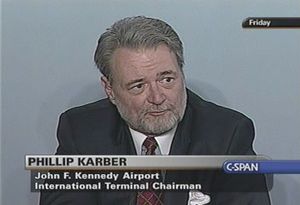Phillip Karber
(academic) | |||||||||||||||||||
|---|---|---|---|---|---|---|---|---|---|---|---|---|---|---|---|---|---|---|---|
 | |||||||||||||||||||
| Nationality | US | ||||||||||||||||||
| Alma mater | Pepperdine University, Georgetown University | ||||||||||||||||||
| Member of | Committee on the Present Danger/Members | ||||||||||||||||||
| Interests | Team B | ||||||||||||||||||
Spooky US academic who attended Bilderberg/1978.
| |||||||||||||||||||
Dr Phillip A. Karber was a US spooky military strategy advisor who as of 2024 was president of the Potomac Foundation. He attended the 1978 Bilderberg meeting, where one of the subjects was Western defense with its political implications.
Education
He graduated of Pepperdine University, received his PhD from Georgetown University specializing in International Aviation Law. He holds advanced certificates from the Harvard Kennedy School as well as from the Wharton and Harvard Business Schools.
Career
Following service in the US Marine Corps, he was brought to Washington by Admiral Arleigh Burke to become a National Security Assistant on the Congressional Joint Committee on Atomic Energy.[1]
He worked with General Donn Starry and the US Army Training and Doctrine Command on Lessons Learned from the 1973 Yom Kippur War.[2]
In 1974 Karber was named Director of the National Security Study Memorandum 186 - the National Security Council inter-agency evaluation of the comparative costs to the U.S. and the USSR to produce, maintain, and operate comparable military forces. "It will assess the status of the competition between the U. S. and USSR in maintaining such forces, trends in the competition, significant areas of comparative advantage or disadvantage to the U. S., and the nature of opportunities and problems implied."[3]
In 1981 Secretary of Defense Caspar Weinberger recruited Karber as a Strategy Advisor, reporting directly to the Secretary of Defense and Chairman of the Joint Chiefs of Staff. He was part of the organizing of Proud Prophet, one of the largest joint tests of US war plans and the only combat simulation in which any Secretary of Defense and Chairman of the Joint Chiefs has ever directly participated.[1]
Between 1977 and 2019, Karber was an Adjunct Professor at Georgetown University.[1]
He also was s consultant to the British Prime Minister Margaret Thatcher, the Secretary General of NATO, and five Supreme Allied Commanders.[4]
After the Cold War
At the end of the Cold War, Karber undertook series of international special projects for the U.S government[1].
- He organized and ran a special team for the U.S. Government that acquired sensitive Soviet military technology. He recruited, trained and delivered the "Free Kuwait Army", to provide coalition forces with language and intelligence support for Operation Desert Storm.[5]
- He implemented the only interviews ever done with top Soviet generals on their Cold War lessons.[1]
- In the MIC revolving door, Karber was for 25 years executive with the BDM Corporation, an international engineering and technology services firm (now part of Northrop Corporation).[1][6]
Between 1997 and 2004 Karber was as Chairman of the Board of JFK International Air Terminal, the international consortium selected by the Port Authority of New York and New Jersey to privatize, rebuild and operate the Kennedy Airport International Arrivals Terminal.[6]
Since 2013 Karber has made 45 trips to Ukraine, including spending 199 days in the combat zone with front-line units, submitting reports directly to NATO's SACEUR, Office of the Secretary of Defense, State Department, NSC and Congress. Wounded under fire in 2015 and seriously injured at the front in February 2024, he is the recipient of numerous Ukrainian awards and several medals, for building bridges for Ukrainian defense industry with its Western counterparts.[1]
In 2022, at the request of the NATO Secretary General, he presented "Ukraine Military Requirements for Counter-Offensive to Regain Sovereignty,' at NATO HQ.[1]
Event Participated in
| Event | Start | End | Location(s) | Description |
|---|---|---|---|---|
| Bilderberg/1978 | 21 April 1978 | 23 April 1978 | US New Jersey Princeton University | The 26th Bilderberg, held in the US |
References
- ↑ a b c d e f g h https://es.ndu.edu/About/Leadership/Leader-Bio/Article/3899414/dr-phillip-a-karber/
- ↑ https://www.uavets.org/phillip-karber/
- ↑ https://irp.fas.org/offdocs/nssm-nixon/nssm_186.pdf
- ↑ https://asb.army.mil/Portals/105/Biography%20Books/2020%20BIO%20BOOKv84_digital.pdf
- ↑ https://issuu.com/hurlinghampolomagazine/docs/spring_08/s/13700324
- ↑ a b https://www.uavets.org/phillip-karber/